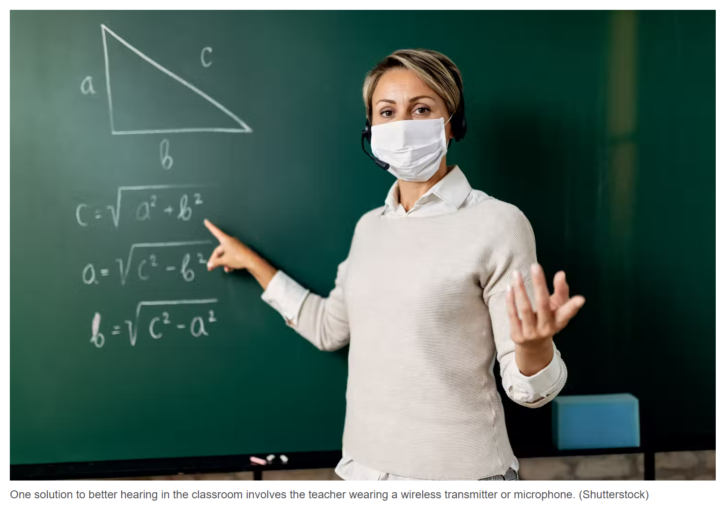Masks, social distancing and increased ventilation are all necessary pandemic measures in classrooms, but they can make for a difficult listening and hearing environment for students and teachers.
While this is true for students with hearing loss, the capacity for COVID-19 measures to affect all students’ ability to hear clearly should also be considered.
Before COVID-19, classrooms already represented less-than-optimal-acoustic environments. It’s also true that young children, children who are learning a new language, children with language difficulties and children with recurrent ear infections have particular difficulty understanding speech in noisy situations.
The Elementary Teachers’ Federation of Ontario recognizes classroom noise as a barrier to teaching and learning.
COVID-19 measures potentially degrade the listening situation further because of masks, which remove visual cues for speech-reading and muffle the speaker’s voice, social distancing, plexiglass barriers or ventilation systems, which can add significant noise into the room.
Masks and hearing
All masks reduce the transmission of speech and reduce visual cues, such as how lips are moving and a person’s facial expression. Researchers from the University of Illinois Augmented Listening Laboratory measured the effect of a wide variety of different masks on speech transmission and found that surgical and KN95 masks provided the least degradation of speech.
All masks reduce high-frequency (high pitched) speech sounds such as those that allow us to hear consonants clearly. For example, hearing the difference between “cap,” “cat” and “cash”. The laboratory researchers found surgical and KN95 masks preserved these high frequencies best.
N95 masks, which have now been provided for teachers in Ontario schools, reduced high-frequency speech sounds more than surgical masks or KN95 masks. For people with normal hearing, listening to someone speak with a mask had only a small effect on understanding of speech when it was quiet, but when there was noise, there was a significant detrimental effect on understanding and people had to work harder to listen. And classrooms almost always have noise.
There are masks available that have a clear plastic insert, so that the speaker’s mouth can be seen. The University of Illinois researchers found that these masks were the worst for understanding speech, as clear masks “strongly degrade high-frequency sounds.”
Ventilation systems
As of August 2021, the Ontario Ministry of Education invested over $550 million in improving and optimizing ventilation and air filtration in schools in the 2020-21 school year. However, ventilation systems potentially add another noise source. According to an August memo to directors of education from the ministry detailing best practices for upgrading ventilation, the “noise rating of a unit should be considered.” But the memo offers no guidance about how to assess noise levels or how much noise is a barrier.
A 2007 study of noise levels in HVAC systems in Minnesota and Arizona classrooms indicated that most systems had noise levels that exceeded acoustical standards. Policies on ventilation, such as the recent May 2021 report from the John Hopkins Bloomberg School of Public Health Center for Health Security, are of course focused on air quality. However, the report touches on noise, noting: “Louder units are cheaper and some jurisdictions may opt for the cheaper units, especially if the quiet ones are sold out, but the additional noise may disrupt learning, which would generate hard-to-quantify costs.”
All of this may add up to students having difficulty hearing the teacher and their classmates. For teachers, having to raise one’s voice to counteract the effects of masks, distance and noise is hard on teachers’ voices as well.
Anecdotally, through my work as an educational audiologist I have heard of some teachers experiencing voice problems due to the necessity to raise their voices for students to hear them, and of some purchasing their own portable speaker systems. Given that we cannot eliminate masks, social distancing and changes to ventilation systems in classrooms, is there another option to help students hear better during in-person learning?
Sound field system technology can help
There is a technology available since the 1980s that was already being used in Canadian classrooms pre-pandemic, with research demonstrating benefits in improved reading skills, student engagement and student attention.
Use of this technology could be expanded to all classrooms. Many students with hearing loss use technology known as FM systems (or Hearing Assistance Technology, HAT) that involve the teacher wearing a wireless transmitter or microphone. The teacher’s voice is transmitted either directly into an individual student’s hearing aids or to a speaker in the classroom.

The version with the teacher’s voice transmitted for everyone to hear is called a sound field system. These systems provide better access to the teacher’s voice under difficult listening conditions and have been shown to benefit students with and without hearing loss.
Sound field systems are a way to use a universal design approach to the problem of hearing in the classroom and some school systems are installing these systems as a response to the pandemic.
Using a sound field system with masks
The University of Illinois researchers studied whether a sound field system could be used in conjunction with masks and found that placing a microphone below the chin effectively preserved of the speech signal. They noted this improvement for all masks — surgical as well as transparent. Sound field systems have the additional benefit of allowing teachers to speak in a regular voice, reducing vocal strain and fatigue.
The COVID-19 pandemic has introduced profound challenges to student learning. We need to do everything we can to support our students in classrooms until COVID-19 measures such as masks and social distancing are no longer needed. Installing sound field amplification technology in all classrooms is one way to ensure that students are able to hear and learn effectively.
Article From: The Conversation
Author: Pam Millett

